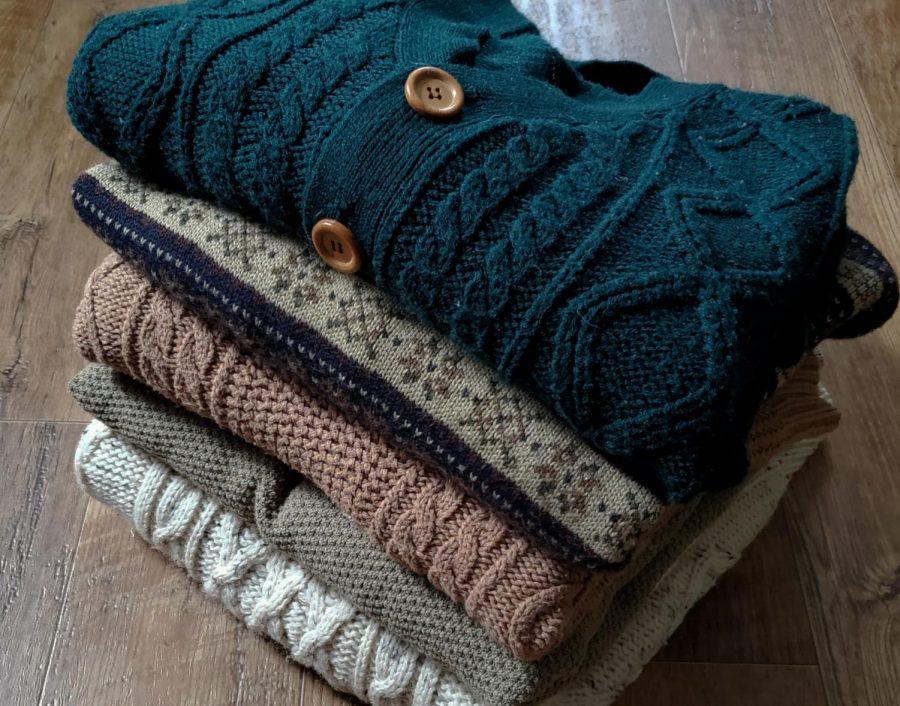Opinion | Consumers should boycott fast fashion and consider more sustainable options
Sarah Cutshall | Visual Editor
Thrifting is a responsible and sustainable alternative to fast fashion.
March 19, 2020
Almost every time I’ve been on Instagram or Facebook lately, I’ve come across a somewhat promising — but slightly sketchy — advertisement for Zaful offering trendy clothes for unbelievably low prices.
After weeks of browsing, I put three items in my cart totalling $14.29 — that would have probably totalled $50 in a store — and hesitantly clicked the “buy now” button, subjecting myself to the world of fast fashion.
Two weeks later, I received three tops that somewhat resembled the pictures online but also were thin and had holes after two washes. Feeling confused, I looked up more customer reviews and found several people with similar experiences — in hindsight, this was something I should have done before buying.
It is alarming how many people — myself included — have been easily drawn into the affordable appeal companies use to overshadow the environmental ills of production and the ambiguity of their suppliers’ practices. Now more than ever is the time to shift to sustainable shopping, as according to environment correspondent Matt McGrath, “the next 18 months will be critical in dealing with the global heating crisis, among other environmental challenges.”
Considering the general consensus on the poor quality of these products, it is also surprising that so many people continue to invest in them. The misleading ads can be traced back to ShenZhen Global Egrow E-Commerce Co., a Chinese clothing company that profited from the stark price differences between clothes in the United States and China in 2008. It successfully targeted the international population, and in 2014, Global Egrow saw a 60% increase in its consumer base across sites such as DressLily, RoseWholesale, RoseGal, SammyDress, Zaful, Nasty Dress, TwinkleDeals and TrendsGal.
However, upon receiving their pieces, consumers saw the substandard quality, and various buyers began to post complaints about their experiences on Facebook, Instagram and blogs. The trend became glaringly clear. On the screen, they saw the next addition to their wardrobe, but what arrived was a mangled-looking cloth or nothing at all. Some buyers claim they had been ripped off while others said, “You got what you paid for.”
What these buyers received was a product these sites capitalize on called single-use clothing — poor-quality clothing that becomes worn out after one or two uses. This, in turn, promotes more purchases, and the pattern contributes to a larger problem as we allow space for fast fashion to grow. Most of this clothing is made from synthetic materials like polyester that release carcinogens during production and won’t decompose in a landfill. Currently the fashion industry takes credit for 10% of annual global emissions — not to mention the yearly 93 billion cubic meters of water waste that’s generated with production. Because of this, the fashion industry’s emissions are expected to increase by 50% in the next decade.
It is easy to disregard these numbers as most of the environmental burden is borne by the top producers in China, India and parts of Southeast Asia. This is due to their loosely enforced environmental and health regulations, not to mention the cheap production rates. Still, with emission rates increasing globally, consumers all over should work to stop catalyzing the cycle of buying, producing and polluting.
Not only this, but as these companies gain revenue, they lose accountability. According to the Fashion Transparency Index, only 10 brands have revealed both their suppliers and distribution facilities. Brands like Zaful and Dresslily have not disclosed their suppliers. In a statement issued to Buzzfeed, they rebutted the claim of unfair labor practices and conditions by arbitrarily referencing the “thousands of different suppliers” the sites claim to use.
Many people find it tempting to turn to fast fashion outlets, despite the presence of more sustainable brands like Pact, Reformation and Everlane. However, these brands aren’t accessible to everyone, mostly due to their high prices. It’s almost like there is a push to choose fast fashion sites.
Taking into account price, convenience and sustainability, a better alternative to this lies within the numerous thrift stores located in the Pittsburgh area. Thrifting, along with being sustainable, is a cheaper alternative to shopping from these brands. Thrift shops— like the University of Thriftsburgh, located right on Pitt’s campus — offer the experience of buying affordable new clothes while promoting sustainability and community.
An added advantage is that durable second-hand clothes are sure to be distinct, as opposed to mass-produced clothing. Even better, purchases made at local volunteer-based stores like East End Community Thrift help to support various charities. With meeting the concerns of convenience and affordability, thrifting is the most sustainable choice as indirect purchases reduce waste in landfills and help local communities.
While online retailers appear to be a convenient choice, consider scrolling past the deceptive ads and heading to a thrift store. Making this sustainable decision plays a small but important role in fighting against the fast fashion phenomenon.



